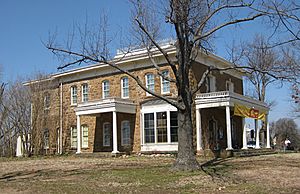Five Civilized Tribes Museum facts for kids
The Five Civilized Tribes Museum is a special place in Muskogee, Oklahoma. It shows off the amazing art, history, and culture of five Native American tribes. These tribes are the Cherokee, Chickasaw, Choctaw, Muscogee (Creek), and Seminole people. The museum is located in the old Union Indian Agency building. It first opened its doors in 1966.
The museum has a huge collection of Native American art from these five tribes. This includes many original artworks by Jerome Tiger (Muscogee/Seminole, 1941–1967). He was a very famous artist.
Contents
Museum History
The idea for the museum started with a group called the Da-Co-Tah Indian Club. In September 1951, they began working to use the Union Indian Agency building for a local museum. In 1954, the club helped create a law. This law asked for the building to be given back to the city of Muskogee, Oklahoma.
The law was passed and signed by President Dwight D. Eisenhower. The museum officially became a non-profit organization on November 19, 1955. Two years later, Marie Wadley (Shawnee/Cherokee) became the museum's first president. The building opened as the Five Civilized Tribes Museum on April 26, 1966. In 2016, Sean Barney became the seventh Executive Director.
The Union Indian Agency Building
The Union Indian Agency Building is a very old and important place. It is listed on the National Register of Historic Places. The Bureau of Indian Affairs built it in the 1870s. It was made to be the home and office for the person in charge of the Five Civilized Tribes. Before this, each tribe had its own office. The Chickasaws and Choctaws shared one office.
The name "Five Civilized Tribes" became popular around the time this building opened. The building was used by the Indian Agency Superintendent and his family.
The Muscogee (Creek) Nation once owned the building. They used it as a school and orphanage for the Creek Freedmen. In 1909, the city of Muskogee, Oklahoma took ownership. The city then gave it to the United States government in 1944. This was to help the Veterans Hospital. However, the building was not used. After World War I, it became a dance hall called “The Chateau.” People came to listen and dance to live music. After World War II, the building became run down. The city and the Da-Co-Tah Indian Club worked hard to fix and restore it.
What You Can See at the Museum
On April 16, 1966, the Da-Co-Tah Indian Club opened the museum's doors. They raised money from people who donated. No money came from the government to fix the building. The museum still follows the goals set by the club.
The museum helps share the art, culture, and history of the Five Tribes. They offer tours to visitors. Downstairs, you can see different exhibits. These shows change often and feature many parts of the tribes' lives and history. Upstairs, you can find old items and art. This art might be from a current art contest or from the museum's own collection.
The museum has a large collection of art. It was made by Cherokee, Chickasaw, Choctaw, Muscogee, and Seminole artists. Some famous artists include Fred Beaver, Johnny Tiger, and Joan Hill. The museum also has the world's largest collection of original works by Jerome Tiger. This includes "Stickballer," his only major sculpture. It is always on display in the gallery.
The Da-Co-Tah Indian Club
The Da-Co-Tah Indian Club had clear goals. Their rules stated that the club wanted to bring members of different Indian tribes closer. They wanted to help each other and have social events. They also wanted to teach everyone about tribal history and achievements. The club was open to all and did not focus on politics.
The women who started the club were all of Native American background. They chose the name “Da-co-tah.” This name comes from the Dakota language and means “Circle of Friends.” They met twice a month. The club colors were red and gold. These colors stood for friendship, strong beliefs, and hope for the future. In 1930, the Da-Co-Tah Indian Club became part of a larger group of clubs.
A famous writer named Grant Foreman wrote these words: "To those pioneer Indians whose courage and fortitude, perseverance and achievement sustained them through travail and disaster and earned for them the name of The Five Civilized Tribes, and who laid the foundation for the State of Oklahoma." These words were printed in a letter sent out before the museum opened in 1966.
The club did many good things for the community. They gave canned food, clothes, and shoes to the Murrow Orphanage. They also made sure the children got haircuts. The club took the children to the Free State Fair once a year. They also took them to see movies and other fun activities. The club raised money to help poor Indian families. They also gave money to the Salvation Army. They helped raise money for drought relief and for people who were unemployed.
Museum Events
Each year, the museum holds art competitions. Tribal members can enter their paintings, pottery, gourd art, sculptures, and more. There is also a student art show every year. Students from the Five Tribes, in grades seven through twelve, can enter their artwork.
Every April, the museum hosts Art Under The Oaks. This is an art market held outside on the museum grounds. Visitors can buy art directly from the artists. All the artists are members of one of the five tribes. You can also see traditional singing and dancing. In November, the museum hosts the Master's Show. This show features works by the best artists from the Five Tribes.
Publications
In 1984, the museum published a cookbook. It was called Pow Wow Chow. It had recipes from Native Americans and others. Years later, Senator Elizabeth Warren submitted six recipes to the cookbook.
Images for kids



